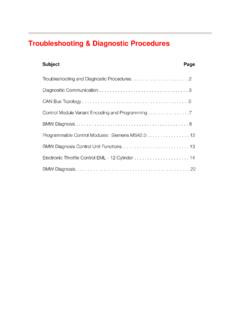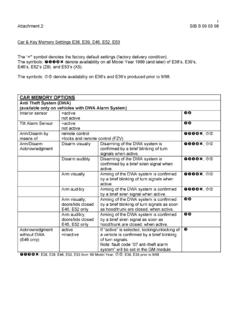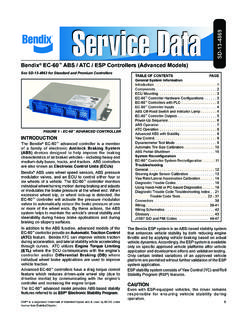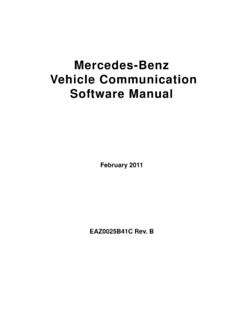Transcription of Electronic Transmission Control Introduction 1-10-03
1 2 Electronic Transmission ControlTable of ContentsSubjectPageAdaptive Features .. 38 Driver Influenced Features .. 39 Environmentally Influenced Features .. 40 CAN Bus communication ..42 Diagnosis and Troubleshooting ..46 Estblishing a Diagnostic Plan ..47 Fault Codes ..48 Identification Page ..49 Diagnostic Program ..50 Test Modules ..51 Diagnostic Tips ..52 Information Resources ..53 TCM Coding and Programming ..54 Transmission Fluid Information ..56 Transmission Fluid Checking Procedures ..57 Transmission Fluid Application ..58 Transmission Service ..59 Transmission Tools ..60 Review Questions ..66 Electronic Transmission Control 38 Electronic Transmission Control Adaptive Features (AGS)AGS features were introduced in 1994 with the A5S560Z Transmission . AGS Control con-sists of adaptive features that will modify Transmission operation according to various fac-tors. AGS operation can be influenced by two major functional groups: Driver influenced features (influenced by throttle and kickdown input) Environmental influences (such as road conditions - icy, traffic etc.)
2 The driving program selection is not adapted on a long term basis - nor is it storedin the Control module memory when the ignition is switched off. It continuallychanges as the driver of the vehicle changes driving Transmission Control Driver influenced features of AGS The adaptive drive program is based primarily on throttle input. The throttle informationcomes from the ECM (DME) via the CAN bus. The TCM continuously monitors the throttleinput for: The current throttle position The rate of change in pedal movement The number of acceleration requests The number of kickdown requestsDrive away EvaluationThe AGS system selects the appropriate shift program based on the amount of accelera-tion that occurs during takeoff. When driving away under full throttle the Transmission willshift from XE to Fast FeatureBased on these inputs, the AGS will select one three different driving programs as follows: Extreme Economy - Shift points are a low speeds for maximum comfort and economy Economy - The shift points are raised for more performance with economy as priority Sport - The shift points are higher to take advantage of full engine full throttle acceleration at high speed, single gear downshifts are possible.
3 A twogear downshift is possible if the accelerator pedal is moved quickly to kick-down. TheExtreme Sport program was eliminated as part of the kick-fast feature. 40 Electronic Transmission Control Environmentally influenced AGS featuresSTOP and GOThe feature is activated by defined sequence of shifts which are as follows: Upshift from first to second - followed by a downshift from second to first - followedby another upshift from first to second. This is then followed by the vehicle comingto a complete this sequence occurs, the Transmission will stay in second gear. The AGS Control hasrecognized stop and go driving and this function will prevent excessive shifting during heavyconditions. The second gear start will be cancelled when: The vehicle speed exceeds 40 MPH The throttle pedal is pressed more than 90% The range selector is moved to Park, Neutral, Reverse or Sport (4,3 or 2) The vehicle is in Sport ModeWinter Drive ProgramThis feature is activated when the TCM detects slippage at the rear wheels by comparingfront and rear wheel speed signals.
4 When slippage is detected by the TCM, the transmis-sion will start in second gear and the shift points will be lowered. This will reduce torque tothe rear wheels allowing improved driveability and traction on slippery roads. 41 Electronic Transmission ControlHill Recognition ProgramThere are two hill recognition programs, one for Uphill and one for Downhill. The TCM willactivate this feature when it receives a high engine load signal at slower road speeds. TheTCM will perceive this information as being consistent with climbing a hill. The shift pointswill be raised to prevent constant up and down shifting. This is referred to as the pendulumshift effect. When driving downhill, road speed will increase with minimal throttle input. TheTCM will detect a downhill situation and hold the current gear to prevent an upshift whengoing downhill. Curve RecognitionThis feature will inhibit upshifts when the vehicle is in a curve.
5 This is to improve stabilitywhen the vehicle is cornering at high speeds. The TCM will initiate this feature when itdetects a difference between left and right (front) wheel speed signals. The difference inthese signals will indicate that the vehicle is in a curve. Be aware that improper tire sizes,brands and inflation pressures can influence this feature. Always address these issues firstwhen diagnosing delayed upshift Control Drive program A special cruise Control shift map is selected by the TCM when cruise Control is active. TheTCM will prevent unwanted locking and unlocking of the torque converter clutch. Also,upshifting and downshifting will be minimized. Depending upon application, the cruise con-trol interfaces with TCM via a single wire data link or as on vehicles with Electronic throttlecontrol, the TCM will interface with the ECM (DME). Manually Selected Extreme Sport ProgramThis feature is activated by moving the shift lever to position 4, 3 or 2.
6 This activates the Extreme Sport Program where the shift points are raised for maximum rpm and perfor-mance. On Steptronic equipped vehicles, the sport program is obtained by moving theshifter to the manual gate to initiate the Sport Program . Modifications to AGS featuresSince the Introduction of AGS features in 1994, there have been some software changesto address customer concerns. Some AGS features have been perceived by the customeras malfunctions. To correct this, some of the AGS features were modified with updatedsoftware. The AGS features previously discussed in this text reflect the updated modifica-tions. Always refer to the latest Service Information Bulletins for more information on AGSfeatures. 42 Electronic Transmission Control CAN Bus CommunicationThe CAN bus is a serial communications bus in which all connected Control units can sendas well as receive information.
7 Data over the CAN bus operates at a rate of up to 1Mb/s(megabits per second).The CAN protocol was developed by Intel and Bosch in 1988 for use in the automotiveindustry to provide a standardized, reliable and cost-effective communications bus to com-bat the increasing size of wiring CAN bus was originally introduced on BMW automobiles in the 1993 E32 740i/IL as adata link between the TCM (EGS) and the ECM (DME).On earlier EGS systems, various signals were transmitted on individual signal wires. Thisreduced reliability and increased the amount of wiring needed. The CAN bus allows fastersignal Transmission and increased versatility. For example, the signals listed in the chartbelow were previously transmitted on individual wires, now these signals are all on the CANbus. This chart represents only some of the signals on the CAN bus, there are many moresignals transmitted between the TCM and ItemReceiverSignal UseECME ngine TemperatureTCMS hift Point CalculationECME ngine Load (tL)TCMS hift Point CalculationECME ngine RPM (TD)TCMTCC SlippageECMT hrottle Position (DKV)TCMS hift Point CalculationECMA/C Compressor ONTCMFine tune shift points to compensatefor increased engine load.
8 TCMT ransmission RangeECME ngine Idle Speed ControlTCMT orque Reduction Signal (ME)ECMT iming Retard during Lockup Status ECME ngine Timing Map Data43 Electronic Transmission Control CAN Bus TopologyThe CAN bus consists of two twisted copper wires. Each wire contains an opposing sig-nal with the exact same information (CAN-High, CAN-Low). The opposing signals trans-mitted through the twisted wire serve to suppress any electrical interference. Early CANbus wiring included a grounded shield around the two wires, later vehicles discarded theshield in favor of the unshielded twisted pair to the linear structure of the network, the CAN bus is available for other modules in theevent of a disconnected or failed Control unit. This is referred to as a Tree structure witheach Control unit occupying a branch. As previously mentioned, the CAN bus initially was used as a high speed communicationlink between the DME and AGS Control the Introduction of the E38 750iL (95 ), the CAN bus was expanded to include theEML and DSC Control modules.
9 The 750iL made exclusive use of the star coupler to linkthe individual CAN bus ends to a common connector. The 1998 model year introduced new users of the CAN bus. The instrument cluster andthe steering angle sensor were linked to expand the signal sharing capabilities of the 1999 750iL was the last vehicle to use the shielded cable, after which the entire CANbus went to twisted pair : Always refer to the proper ETM to determine the exact wiring configurationfor a specific Transmission Control On models that use twisted pair, the wire color of the CAN bus is uniform throughout thevehicle with: CAN-Low GE/BR and CAN-High GE/SW or GE/RT. Shielded wiring is easilyidentified by the black sheath surrounding the CAN bus. Troubleshooting the CAN BusThe failure of communication on the CAN bus can be caused by several sources: Failure of the CAN bus cables. Failure of one of the Control units attached to the CAN.
10 Failure of the voltage supply or ground to individual modules. Interference in the CAN bus of the CAN bus cablesThe following faults can occur to the CAN bus wiring: CAN-H/L interrupted CAN-H/L shorted to battery voltage CAN-H/L shorted to ground CAN-H shorted to CAN-L Defective plug connections (damaged, corroded, or improperly crimped)In each instance, the connected Control units will store a fault due to the lack of informationreceived over the CAN most current models the CAN bus pro-vides data exchange between the followingcontrol modules: ECM (DME) EML (750iL E38) TCM (EGS) IKE/Kombi ASC/DSC LEW 45 Electronic Transmission Control The voltage of the CAN bus is dividedbetween the two data lines: CAN-Highand CAN-Low for an average of perline. The voltage measurement is takenfrom each data line to ground. Each mod-ule on the CAN contributes to this voltage.
















